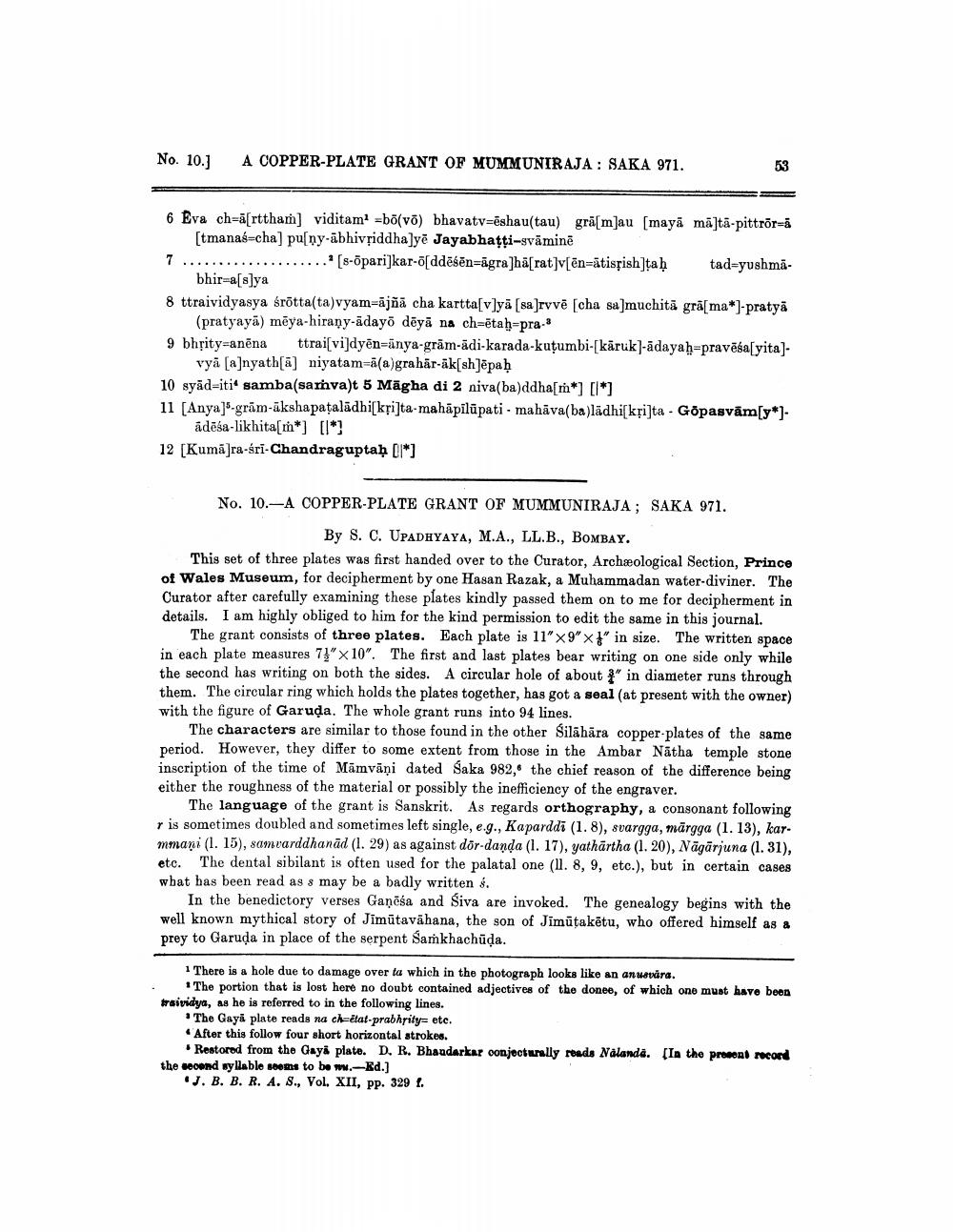________________
No. 10.
A COPPER-PLATE GRANT OF MUMMUNIRAJA: SAKA 971.
6 Eva ch-a[rttham] viditam =bö(vo) bhavatv=ēshau(tau) grā[m]au (mayi maltā-pittröreä
[tmanas-cha) pu[ny-abhivriddha]yē Jayabhatti-yväminē 7 ...... ............ (s-õpari]kar-o[ddēšēn=āgra]hä[rat]v[ën=ātisșish]taḥ tad=yushma
bhir=a[s]ya 8 ttraividyasya śrótta(ta)vyam=ājñā cha kartta[v]yā [sa]rvvē [cha sa]muchitā grā[ ma*)-pratya
(pratyayā) mēya-hirany-ādayo dēyā na ch=ētah-pra. 9 bhțity=anëna ttrai[vi]dyēn=ünya-grām-ādi-karada-kuțumbi-[kāruk]-ādayah=pravēša[yita)
vyā [a]nyath[a] niyatam=ā(a)grahār-āk[sh]ēpaḥ 10 syād=iti samba(samva)t 5 Māgha di 2 niva(ba)ddha[m*] [*] 11 [Anya] -grām-ākshapatalādhi[kři]ta-mahāpīlūpati - mahāva(ba)lādhi[kțista - Göpasvām[y*]
ādēša-likhita[m*] [l*} 12 [Kumā]ra-sri-Chandraguptaḥ [1*]
No. 10.-A COPPER-PLATE GRANT OF MUMMUNIRAJA; SAKA 971.
By S. C. UPADHYAYA, M.A., LL.B., BOMBAY. This set of three plates was first handed over to the Curator, Archaeological Section, Prince of Wales Museum, for decipherment by one Hasan Razak, a Muhammadan water-diviner. The Curator after carefully examining these plates kindly passed them on to me for decipherment in details. I am highly obliged to him for the kind permission to edit the same in this journal.
The grant consists of three plates. Each plate is 11" x 9" x 1" in size. The written space in each plate measures 7}" x 10". The first and last plates bear writing on one side only while the second has writing on both the sides. A circular hole of about fin diameter runs through them. The circular ring which holds the plates together, has got a seal (at present with the owner) with the figure of Garuda. The whole grant runs into 94 lines.
The characters are similar to those found in the other Silāhāra copper-plates of the same period. However, they differ to some extent from those in the Ambar Nätha temple stone inscription of the time of Māmvāņi dated Saka 982, the chief reason of the difference being either the roughness of the material or possibly the inefficiency of the engraver.
The language of the grant is Sanskrit. As regards orthography, a consonant following r is sometimes doubled and sometimes left single, e.g., Kaparddi (1.8), svargga, mārgga (1. 13), karmmani (1. 15), samvarddhanād (1. 29) as against dör-danda (1. 17), yathartha (1. 20), Nāgārjuna (1. 31), etc. The dental sibilant is often used for the palatal one (11. 8, 9, etc.), but in certain cases wbat has been read as s may be a badly written s.
In the benedictory verses Gaņēsa and Siva are invoked. The genealogy begins with the well known mythical story of Jimütavahana, the son of Jimütakētu, who offered himself as & prey to Garuda in place of the serpent Samkhachūda.
1 There is a hole due to damage over ta which in the photograph looks like an anusvåra.
* The portion that is lost here no doubt contained adjectives of the donee, of which one must have been traividya, as he is referred to in the following lines.
* The Gayā plate reads na ch=etat-prabhrity= etc. After this follow four short horizontal strokes.
Restored from the Gaya plate. D. R. Bhaudarkar conjecturally roads Nalanda. [In the present record the second syllable seems to be w.-Ed.]
"J. B. B. R. A. 8., Vol. XII, PP. 329 1.




